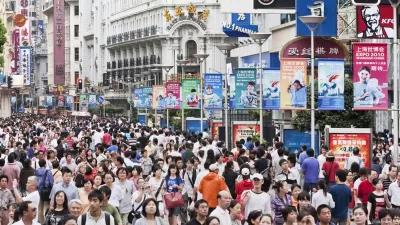The Communist Party announced on Nov. 15 two huge changes to two long-term policies that exerted enormous control over its citizens. More couples will be allowed to have additional children and "reeducation through labor camps" will be abolished.
The two moves, "issued by the official news agency, Xinhua," show that the Communist Party is choosing to give up on its "power to control citizens' lives," writes Chris Buckley. Already, the controversial one-child policy, "introduced in the late 1970s" according to Xinhua, had been changed to allow urban couples to have "two children if both parents are single children..Many rural couples already have two children, and some have more", writes Buckley.
The new policy extends the second-child policy to couples where only one spouse is an only child.
If carried through, the relaxation would be the first significant nationwide easing of family size restrictions that have been in place since the 1970s, said Wang Feng, a demographer who teaches at both the University of California, Irvine, and Fudan University in Shanghai. He estimated the policy could lead to one million to two million more births in China every year, on top of the approximately 15 million births a year now.
Buckley writes that the "one-child restrictions were introduced to deal with official fears that China’s population would devour too many resources and suffocate growth. But they have created public ire and international criticism over forced abortions, and have created a population of 1.34 billion, according to a 2010 census, that is aging relatively rapidly, even before China establishes a firm foothold in prosperity. Experts have for years urged some relaxation of the controls."
The Wall Street Journal's Beijing correspondent, Laurie Burkitt, makes clear that a major reason for the policy change was the country's looming labor shortage, which will "[put] a great strain on the nation's safety net", as mentioned in her video. But will it be enough to change the nation's looming labor crisis?
Burkitt writes that "demographers say the shift, in the document charting China's economic course for the next decade, comes too late to solve a looming labor crisis in a rapidly aging society."
[See WSJ graphs of two population projections: growth peaking in the 2020s and growing aging population].
The population and labor camp policy changes were not the only ones endorsed by President Xi Jinping on Friday. They were part of 60 initiatives "that also laid out broad and potentially far-reaching proposals to restructure the economy by encouraging greater private participation in finance, vowing market competition in several important parts of the economy, and promising farmers better property protection and compensation for confiscated land," writes the Times' Buckley.
"The system of forced labor camps that Communist Party leaders announced they're abolishing, established in 1957, allows police to imprison people for up to four years without formal arrest or trial," states PBS NewsHour's Jeffrey Brown in Part 1 of their new report on the policy changes.
However, guest Kenneth Roth, executive director of Human Rights Watch, clarifies that "China is not abolishing labor camps" in Part 2.
It's abolishing one of the means that people are put in labor camps, the so-called reeducation through labor. About two-thirds of the people sentenced through reeducation through labor are drug users.
FULL STORY: China to Ease Longtime Policy of 1-Child Limit

Study: Maui’s Plan to Convert Vacation Rentals to Long-Term Housing Could Cause Nearly $1 Billion Economic Loss
The plan would reduce visitor accommodation by 25,% resulting in 1,900 jobs lost.

North Texas Transit Leaders Tout Benefits of TOD for Growing Region
At a summit focused on transit-oriented development, policymakers discussed how North Texas’ expanded light rail system can serve as a tool for economic growth.

Why Should We Subsidize Public Transportation?
Many public transit agencies face financial stress due to rising costs, declining fare revenue, and declining subsidies. Transit advocates must provide a strong business case for increasing public transit funding.

How to Make US Trains Faster
Changes to boarding platforms and a switch to electric trains could improve U.S. passenger rail service without the added cost of high-speed rail.

Columbia’s Revitalized ‘Loop’ Is a Hub for Local Entrepreneurs
A focus on small businesses is helping a commercial corridor in Columbia, Missouri thrive.

Invasive Insect Threatens Minnesota’s Ash Forests
The Emerald Ash Borer is a rapidly spreading invasive pest threatening Minnesota’s ash trees, and homeowners are encouraged to plant diverse replacement species, avoid moving ash firewood, and monitor for signs of infestation.
Urban Design for Planners 1: Software Tools
This six-course series explores essential urban design concepts using open source software and equips planners with the tools they need to participate fully in the urban design process.
Planning for Universal Design
Learn the tools for implementing Universal Design in planning regulations.
City of Santa Clarita
Ascent Environmental
Institute for Housing and Urban Development Studies (IHS)
City of Grandview
Harvard GSD Executive Education
Toledo-Lucas County Plan Commissions
Salt Lake City
NYU Wagner Graduate School of Public Service



























